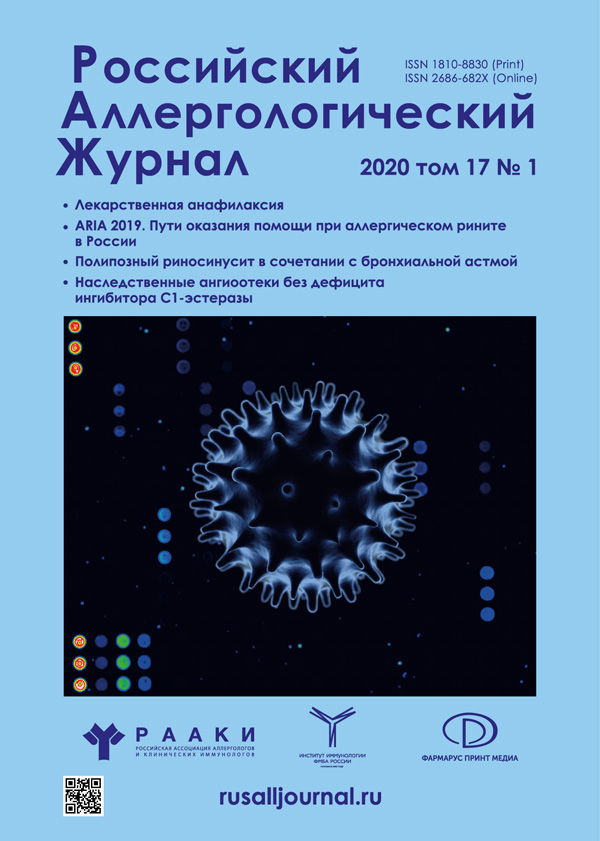Polypous rhinosinusitis in combination with bronchial asthma: clinical features and cellular characteristics of local and systemic inflammation
- Authors: Kurbacheva O.M.1, Dyneva M.E.1, Shilovskii I.P.1, Savlevich E.L.2, Kovchina V.I.1, Nikolskii A.A.1, Savushkina E.I.2, Khaitov M.R.3
-
Affiliations:
- NRC Institute of Immunology FMBA of Russia
- Federal State Budgetary Institution of Higher Professional Education “Central State Medical Academy” of the Office of the President of the Russian Federation
- National Research Center - Institute of Immunology Federal Medical-Biological Agency of Russia
- Issue: Vol 17, No 1 (2020)
- Pages: 32-49
- Section: Articles
- URL: https://journals.rcsi.science/raj/article/view/121652
- DOI: https://doi.org/10.36691/RAJ.2020.17.1.003
- ID: 121652
Cite item
Full Text
Abstract
Keywords
Full Text
##article.viewOnOriginalSite##About the authors
Oksana Mikhailovna Kurbacheva
NRC Institute of Immunology FMBA of Russia
Email: kurbacheva@gmail.com
доктор медицинских наук, профессор, зав. отделением бронхиальной астмы
Miramgul Esengeldyevna Dyneva
NRC Institute of Immunology FMBA of Russia
Email: amanturliva.miramgul@mail.ru
аспирант отделения бронхиальной астмы
Igor Petrovich Shilovskii
NRC Institute of Immunology FMBA of Russia
Email: igorshilovski@gmail.com
доктор биологических наук, зам. директора по науке и инновациям
Elena Leonidovna Savlevich
Federal State Budgetary Institution of Higher Professional Education “Central State Medical Academy” of the Office of the President of the Russian Federation
Email: savllena@gmail.com
кандидат медицинских наук, доцент кафедры оториноларингологии
Valeriia Ivanovna Kovchina
NRC Institute of Immunology FMBA of Russia
Email: kvi91@mail.ru
младший научный сотрудник
Aleksandr Arkadevich Nikolskii
NRC Institute of Immunology FMBA of Russia
Email: aa.nikolskii@nrcii.ru
аспирант
Elizaveta Iurevna Savushkina
Federal State Budgetary Institution of Higher Professional Education “Central State Medical Academy” of the Office of the President of the Russian Federation
Email: lizasavushkina@mail.ru
аспирант
Musa Rakhimovich Khaitov
National Research Center - Institute of Immunology Federal Medical-Biological Agency of Russia
Email: mr.khaitov@nrcii.ru
доктор медицинских наук, профессор, член-корр. РАН, директор
References
- Kim DW, Cho SH. Emerging endotypes of chronic rhinosinusitis and its application to precision medicine. Allergy Asthma Immunol Res. 2017;9(4):299-306. DOI: 10.4168/ aair.2017.9.4.299.
- Fokkens WJ, Lund VJ, Mullol J, Bachert C, Alobid I et al. European position paper on rhinosinusitis and nasal polyps. Rhinol Suppl. 2012;50(23):1-298. DOI: 10.2500/ ajra.2013.27.3925.
- Serrano E, Neukirch F, Pribil C, Jankowski R, Klossek JM et al. Nasal polyposis in France: impact on sleep and quality of life. J Laryngol Otol. 2005;119(7):543-549. doi: 10.1258/0022215054352108.
- Савлевич ЕЛ, Гаганов ЛЕ, Егоров ВИ, Курбачева ОМ, Герасимов АН, Шачнев КН. Сравнительное пилотное исследование эндотипов хронического полипозного риносинусита у пациентов, проживающих в разных географических регионах Российской Федерации. Иммунология. 2018;39(4):208-213. doi: 10.18821/0206-49522018-39-4-208-213.
- Шиловский ИП, Дынева МЕ, Курбачева ОМ, Кудлай ДА, Хаитов МЕ Роль интерлейкина-37 в патогенезе аллергических заболеваний. ACTA NATURAE. 2019;4(43):54-64. doi: 10.32607/20758251-2019-11-4-54-64.
- Курбачева ОМ, Павлова КС. Фенотипы и эндотипы бронхиальной астмы: от патогенеза и клинической картины к выбору терапии. Российский Аллергологический Журнал. 2013;10(1):15-24.
- Chaaban MR, Walsh EM, Erika M, Woodworth BA et al. Epidemiology and differential diagnosis of nasal polyps. Am J Rhinol Allergy. 2013;27(6):473-478.
- Савлевич ЕЛ, Дынева МЕ, Гаганов ЛЕ, Егоров ВИ, Герасимов АН, Курбачева ОМ. Лечебно-диагностический алгоритм при разных фенотипах полипозного риносинусита. Российский Аллергологический Журнал. 2019;16(2):50-61.
- Soler ZM, Mace JC, Litvack JR, Smith TL. Chronic rhinosinusitis, race, and ethnicity. Am J Rhinol Allergy. 2012;26:110-116. doi: 10.2500/ajra.2012.26.3741.
- Дынева МЕ, Курбачёва ОМ, Савлевич ЕЛ. Бронхиальная астма в сочетании с хроническим полипозным риносинуситом: эпидемиология, распространенность и особенности их взаимоотношения. Российский Аллергологический Журнал. 2018;15(1):16-25.
- Stevens WW, Peters AT, Hirsch aG, Nordberg CM, Schwartz BS et al. Clinical Characteristics of Patients with Chronic Rhinosinusitis with Nasal Polyps, Asthma, and Aspirin-Exacerbated Rbiespiratory Disease. J Allergy Clin Immunol Pract. 2017;5(4):1061-1070. doi: 10.1016/j.jaip.2016.12.027.
- Mortuaire G, Gengler I, Balden M, Capron M, Lefevre G. Impact of allergy on phenotypic and endotypic profiles of nasal polyposis. European Annals of Otorhinolaryngology Head and Neck Diseases. 2017;135:159-162. DOI: 10.1016/j. anorl.2017.11.005.
- Курс патогистологической техники. Под ред. Меркулова ГА. Л.: Медгиз; 1961.
- Yeganeh C, Xia H, Movassagh C, Koziol-White Chang Y et al. Emerging mediators of airway smooth muscle dysfunction in asthma. Pulm Pharmacol Ther. 2013;26(1):105-111. doi: 10.1016/j.pupt.2012.06.011.
- Raedler D, Ballenberger N, Klucker E, Bock A et al. Identification of novel immune phenotypes for allergic and nonallergic childhood asthma. J Allergy Clin Immunol. 2015;135(1):81-91. doi: 10.1016/j.jaci.2014.07.046.
- Lin DC, Chandra RK, Tan BK, Zirkle W Conley DB et al. Association between severity of asthma and degree of chronic rhinosinusitis. Am J Rhinol Allergy. 2011;25:205-208. doi: 10.2500/ajra.2011.25.3613.
- Чичкова НВ. Бронхиальная астма и полипозный риносинусит: особенности клинического течения и тактика ведения больных. Астма и аллергия. 2015;1:19-22.
- Yacoub MR, Trimarchi M, Cremona G, Dal Farra S et al. Are atopy and eosinophilic bronchial inflammation associated with relapsing forms of chronic rhinosinusitis with nasal polyps? Clin Mol Allergy. 2015; 13(1):1-6. doi: 10.1186/s12948-015-0026-8.
- Pearlman AN, Chandra RK, Chang D, Conley DB et al. Relationships between severity of chronic rhinosinusitis and nasal polyposis, asthma, and atopy. Am J Rhinol Allergy 2009;23(2):145-148. doi: 10.2500/ajra.2009.23.3284.
Supplementary files






